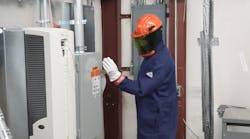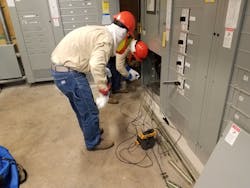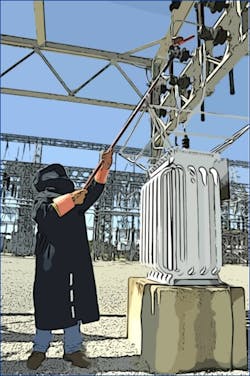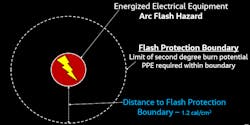Within the electrical industry, most workers have become familiar with the term arc flash and the hazard it represents. While training and education have helped in understanding the hazard as well as methods for workers to protect themselves from it, there are still some gaps in industry application that need to be addressed. The following is a collection of some of the most common fallacies that arise when working with companies that are developing their electrical safety programs. Before jumping into the various misconceptions, it’s important to establish a clear understanding of what the arc flash hazard is.
An arc flash is a violent eruption of energy from an electrical source that happens when the electrical energy travels from a conductor through the air to another conductor or grounded component. The arc temperature can exceed 35,000°F, which is more than three times the estimated temperature of the surface of the sun. Unlike a shock hazard, workers do not have to come into contact with the piece of equipment to be injured by an arc flash. Fatal burns can occur at distances of more than 10 feet.
The extremely high temperatures of the arc flash also result in what is called an arc blast. This is a pressure wave that is caused by the heating and rapid expansion of the surrounding air to a plasma. When air reaches these temperatures in a span of milliseconds, the ionized air explodes away from the source being driven by magnetic forces. These blasts are prominent at higher fault currents and can have the force and magnitude of an explosive device.
Understanding the severity involved in an arc flash event makes it clear that the hazard needs to be taken very seriously, and electrical professionals must do everything possible to avoid exposure to this hazard. The first, and arguably most important, step in protecting workers is knowledge. Everyone working around electrical equipment needs to know when the hazard exists and what can be done to protect themselves from the potentially severe outcome of an arc flash event. While this will not be fully exhaustive, the following scenarios will hopefully help to clarify some misunderstandings, point out misapplications, and put forth recommendations for avoiding injury or death from an arc flash event.
The “High-Voltage” Fallacy
When assessing a company’s electrical safety program, I typically start by interviewing various categories of employees to get a feel for the type of work they perform as well as any hazards to which they may be exposed. In these discussions, I often hear a commonly used misleading statement: “I don’t work with ‘high voltage’ so I don’t have to worry about arc flash hazards.” The problem is that this implies a connection between the voltage rating and the severity of an arc flash event. The truth is that arc flash hazards are essentially voltage-independent. The severity of an arc flash hazard is more directly related to the available fault current and the amount of time it takes the upstream overcurrent protective device (OCPD) to clear the fault. We also need to recognize that “high voltage” means different things depending on the worker’s perception. Exposure to energized 480VAC, for example, can constitute a very serious arc flash hazard.
Another variant of this thought is: “I am only a controls technician. Anything over 48V, and I get an electrician to work on it.” In general, this is a good approach for someone to take. However, it is important to communicate the difference between working “on something” and working “exposed to something.” I often follow workers who make this statement into the field to let them show me the systems on which they work. Far too often, they will open an enclosure to show me the control system for which they are responsible. What they don’t realize is that in the same enclosure is a 480VAC circuit with exposed termination points that pose an arc flash hazard.
It is important to educate workers to look beyond the circuit or components with which they are specifically interacting and look at the bigger picture to identify anything to which they are exposed. Workers must be protected from the hazard any time they are within the arc flash protection boundary, regardless of whether they are working on that circuit or an adjacent control circuit. Any task performed inside an arc flash protection boundary could result in inadvertently contacting the energized conductor, resulting in an arc flash event. Any time a worker opens an electrical enclosure, he or she should evaluate what they are exposed to rather than just what they are working on.
The “Closed-Door” Fallacy
Although this is not as common as it used to be, I still run across workers who believe as long as the breaker enclosure door is closed there is no need for arc flash PPE when operating a breaker. The only time that it is safe to operate a circuit breaker with no arc flash PPE on is if the risk assessment verifies there is no arc flash hazard, or the equipment is arc-rated and installed and operated per the manufacturer’s instructions. If the risk assessment verifies an arc flash hazard potential exists, then the appropriate level of PPE must be worn to operate the breaker. Not only do the breaker enclosures have vents that will allow the super-heated air and gasses out of the enclosure, but arc flash events have also been shown to blow doors open, melt through metal barriers, and even strip bolts out of their holes to allow the pressure wave to escape — not to mention the common practice of only tightening enough of the latches/bolts to hold the enclosure/panel in place so that it’s easier to remove on the next maintenance cycle, which is not an acceptable practice.
The “No Maintenance” Fallacy
Some companies are misled to believe that if they contract all of their electrical maintenance work out, then they do not need to worry about any arc flash hazards. Article 100 of the NFPA 70E defines the arc flash hazard. The definition explains that not only does the hazard exist when there are exposed energized conductors, but also when interacting with the equipment in a manner that could result in an arc flash event. The task of opening and closing breakers and switches is known to be an interaction that could result in an arc flash event. This means that anyone operating electrical distribution equipment that has not been verified through a risk assessment to be free from an arc flash hazard must take the appropriate actions to ensure they are protected from the arc flash hazard potential.
The “Some Are Better Than None” Fallacy
There are times when a worker has Category 2 PPE with them, but the equipment they are to operate requires Category 4 PPE. Human nature tempts the worker to just put on what they have rather than go get the appropriately rated PPE. The problem with this is that underrated arc flash PPE may not protect the worker. Arc flash PPE is rated one of two ways: arc thermal performance value (ATPV) and energy breakopen threshold (EBT). ATPV is the amount of energy the material can withstand without burning through the material. EBT is the amount of energy an article of clothing can withstand without ripping open the seams or fasteners. The rating given to the arc flash PPE is the lowest of these two values. If the PPE is not rated sufficiently for the potential hazard, then the arc flash could either burn through the PPE or break it apart and ignite any under layers. Workers must remain outside the arc flash protection boundary unless they are wearing appropriately rated arc flash PPE.
The “Downstream Assumption” Fallacy
This fallacy stems from this belief: “If a panel is rated less than 1.2 cal/cm2, then everything else downstream is also less than 1.2 cal/cm2.” This seems like it is a logical assumption, and — in a lot of cases — it will likely be correct. However, considering the severity of the outcome of an arc flash event, it is not safe to make this assumption. Consider a scenario where the available fault current is just on the very edge of the instantaneous trip curve at the upstream device, then there is a long run of conductor before terminating at the next disconnecting means. The long conductor may introduce enough impedance into the circuit that the current drops below the instantaneous setting and now requires a time delay setting to clear the fault. This scenario adds time to the clearing time, which will increase the incident energy level and potentially require a higher level of arc flash PPE to safely operate that device. The other more common scenario is that there is a transformer downstream. Transformers will impact the arc flash value. It is not uncommon for a medium-voltage switch on one side of the transformer will be less than 1.2 cal/cm2 and the 480V breaker on the secondary side of the transformer will be over 30 cal/cm2. The bottom line is that employers must assess equipment operating at 50V or more for shock and arc flash hazards. If the equipment has not been through an assessment, do not make any assumptions on the magnitude of the hazard.
The “NFPA 70E Exemption” Fallacy
This is a philosophy that some companies adopt to rationalize how they can consider themselves exempt from the NFPA 70E requirements. The fallacy sounds like this: “We do not employ electricians; we sub out all of our electrical work. Therefore, the NFPA 70E does not apply to us.” However, the NFPA 70E does have requirements for employers who contract out electrical work. The host employer is required to communicate to the contractor any known hazards in the work area as well as any information about the installation to assist in their risk assessments. The host employer is also expected to report any electrical safety violations they observe by the contractor’s employees.
The owner of electrical equipment also has requirements related to the equipment regardless of their position on operations and maintenance of the equipment. The NFPA 70E states that the owner is responsible for the documentation, installation, and maintenance of the equipment labeling that provides arc flash hazard details to include the arc flash boundary and a means to determine what arc flash PPE is required. The method for determining the information on the label must be documented and reviewed for accuracy at intervals not to exceed five years. The equipment owner is also responsible for the maintenance of the electrical equipment and documentation. Essentially, the owner is responsible for ensuring the health of the equipment, documenting the arc flash hazard, and assisting the contractor in their hazard risk assessment by providing location-specific hazards.
The “We Have Checked All the Boxes” Fallacy
There have been companies that learned the major NFPA 70E requirements and take the position: “Our arc flash analysis is complete, arc flash warning labels are posted, and our employees have been trained on electrical safety. We are fully compliant!” While those are all good steps in the right direction, the journey does not end by checking those boxes. NFPA 70E Sec. 110.5 lists 12 specific items that need to be included in a company’s electrical safety program. All of these items must be documented and periodically reviewed. A company’s journey to being NFPA 70E-compliant is not a one-time effort, but rather an ongoing process of developing a culture of safe work practices while maintaining alignment with the NFPA 70E requirements as they get revised.
One often ignored or overlooked requirement is the various audits that are required for a compliant electrical safety program. Three primary audits must be periodically performed and documented. The first one is an audit of the overall electrical safety program. This is required to be done on a three-year interval, the same revision frequency as the NFPA 70E, and is intended to verify that the program’s principles and procedures comply with the latest NFPA 70E requirements. Employers are also required to audit fieldwork on an annual basis. The objective of this audit is to verify that the electrical workers are compliant with the principles and procedures of the company and the requirements communicated in the electrical safety training. The third primary audit is for the lockout/tagout (LOTO) program and procedures. This is required to be audited annually on at least one LOTO that is in progress to verify the accuracy and completeness of the program, procedures, and training. All three of these audits must be documented.
The “PPE First” Fallacy
This is the belief that some electrical workers have related to the idea that their employer gave them the arc flash PPE, so let’s just put it on and get the work done. PPE should be viewed as the last line of defense and used only after all other options have been exhausted. Article 130 of the NFPA 70E requires an arc flash risk assessment to include evaluating electrical tasks using the hierarchy of risk control method. Electrical professionals should always evaluate methods for eliminating the hazard, shielding themselves from the hazard, and any other step to keep workers out of the line of fire. If our risk assessment results in no other option than being exposed to the potential arc flash hazard, then the employee determines the appropriate PPE needed to execute the task safely.
An example of managing this mindset to drive a positive culture can be seen in an approach I have used for voltage-rated tools. When managing a group of electrical workers, I provided them with electrical safety training, which included the requirement for voltage-rated tools when working inside the restricted approach boundary (RAB) of exposed energized conductors. After the training, I was told that they all needed to be provided with individual sets of voltage-rated tools because on any given day they could receive a maintenance task that would require performing work inside the RAB. Knowing that I was the author and provider of the electrical safety training that taught them the requirement, you can imagine their surprise when I declined their request.
I explained that if I provided each employee with their own set of voltage-rated tools, I am implying that I expect them all to perform repair-type work within the RAB when, in fact, my expectation is the exact opposite. Instead of individually issued tools, I provided two toolboxes with voltage-rated tools that were kept locked, and I retained the keys. Working inside the RAB for non-diagnostic tasks requires an energized electrical work permit (EEWP). A task that would require voltage-rated tools also required an EEWP approved by me. If the EEWP and hazard risk assessment process resulted in verifying that the task was infeasible to complete in an electrically safe work condition, then I would approve the plan and provide a key to the voltage-rated tools. The result was that those tools rarely were used because the process worked as intended. Instead of jumping right in and executing the task with PPE, we took some time to think about what needed to be done and determine if there was a way to do the work while minimizing the need for PPE. In most cases, we found ways to execute the task with significantly reduced exposure to electrical hazards.
That scenario demonstrates the goal of the requirements for an electrical safety program. The goal is to drive a culture of continuous evaluation of how we execute our tasks with the mindset of minimizing our exposure to hazards. The days of ‘taking risks because we are electrical workers and we knew the risk when we signed up for the job’ is over. There is no task in the electrical industry that is important enough to risk our life to execute. Given what we understand about electrical hazards and the procedures and technology available, there is no reason for anyone to ever be injured or killed by an electrical hazard. There is always a method for protecting workers from the hazard. The solution is in driving a culture that prioritizes safety at work and home so that taking risks is replaced with taking time to plan the work to be executed safely.
For more information on arc flash myths, listen to the free on-demand webinar presented by Tommy Northcott to the EC&M audience earlier this year at https://bit.ly/3A7Zohm.
Northcott is a professional engineer licensed in the state of Tennessee and a senior power engineer with Jacobs Technology, Inc., in Tullahoma, Tenn. He is also an NFPA 70E compliance subject matter expert, a principal member of the NFPA 70B Committee, electrical safety trainer, certified maintenance and reliability professional, and certified reliability leader. He can be reached at [email protected].









